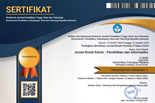Pengenalan Pola Garis Telapak Tangan Menggunakan Metode Fuzzy K-Nearest Neighbor
Abstract
Abstrak
Pengenalan telapak tangan merupakan sistem biometrik yang digunakan untuk pengenalan individu pada penggunaan proses autentikasi atau password untuk mendapatkan hak akses. Ini karena telapak tangan memiliki karakteristik unik, dan cenderung stabil. Selain itu, pengenalan telapak tangan tidak mengganggu kenyamanan seseorang saat pengambilan citra. Namun hingga kini masih ada kendala pada sistem pengenalan telapak tangan. Seperti gambar garis telapak yang tidak dalam kondisi baik untuk dikenali, karena diambil dengan menggunakan kamera biasa. Oleh karena itu,. Untuk mendapatkan pengenalan pola telapak tangan yang baik, penelitian ini menggunakan ekstraksi fitur morfologi dan pengenalan pola garis telapak tangan dengan metode Fuzzy K-Nearest Neighbor (FKNN). Berdasarkan hasil percobaan yang dilakukan, penggunaan metode Fuzzy K-Nearest Neighbor (FKNN) dalam pengenalan pola garis telapak tangan diperoleh nilai akurasi tertinggi sebesar 93%, dan untuk nilai akurasi rata-rata sebesar 82,6%.
Kata kunci: Fuzzy K-Nearest Neighbor (FKNN), Pengenalan Telapak Tangan
Abstract
The introduction of the palms is a biometric system used for individual recognition on the use of the authentication process or password to gain access rights. This is because the palms have unique characteristics, and tend to be stable. In addition, the introduction of the palm does not interfere with one's comfort when taking the image. But until now there are still obstacles in the system of recognition of the palm of the hand. Such as palm line drawings that are not in good condition to be recognized, as taken with ordinary camera. Therefore,. To obtain a good palm line image, this study used morphological feature extraction and palm pattern recognition using the Fuzzy K-Nearest Neighbor (FKNN) method. Based on the experimental results, the use of Fuzzy K-Nearest Neighbor (FKNN) method in recognition of palm pattern pattern obtained the highest accuracy value of 93%, and for the average accuracy value of 82.6%.
Full Text:
PDFReferences
AFTAR PUSTAKA
Afriandi, E., & Sutikno. (2016). Identifikasi Telapak Tangan Menggunakan Jaringan Syaraf Tiruan Learning Vector Quantization (LVQ). Jurnal Infotel, 8(2), 107-114.
Chin, Y. J., Ong, T. S., Teoh, A. J., & Goh, K. M. (2014). Integrated Biometrics Template Protection Technique Based on Fingerprint and Palmprint Feature-Level Fusion. ELSEVIER, 18(0), 161-174.
Keller, J. M., Gray, M. R., & Given, J. A. (1985). A Fuzzy K-Nearest Neighbor Algorithm. IEEE Transactions on System, man, and cybernetics(4), 580-585.
Kusban, M. (2015). Verifikasi dan Identifikasi Telapak Tangan dengan Kernel Gabor. JNTETI, 4(2).
Liu, E., Jain, A. K., & Tian, J. (2013). A Coarse to Fine Minutiac-Based Latent Palmprint Matching. IEEE Transactions on Pattern Analysis and Machine Intelligence, 35(10), 2307-2322.
Putra, I. G. (2007). Sistem Verifikasi Menggunakan Garis-Garis Telapak Tangan. Jurnal Kampus Bukit Jimbaran, 6(2), 46-51.
Renaningtias, N., Efendi, R., & Susilo, B. (2015). Aplikasi Biometrika Pencocokan Citra Garis Telapak Tangan Dengan Metode Transformasi Wavelet Dan Mahalanobis Distance. Jurnal Rekursif, 3(2), 95-106.
DOI: https://doi.org/10.21107/edutic.v4i1.3385
Refbacks
- There are currently no refbacks.
Copyright (c) 2017 nurul fajriani

This work is licensed under a Creative Commons Attribution 4.0 International License.
Indexed by:
 J. Ilm. Edutic is licensed under a Creative Commons Attribution 4.0 International License.
J. Ilm. Edutic is licensed under a Creative Commons Attribution 4.0 International License.















